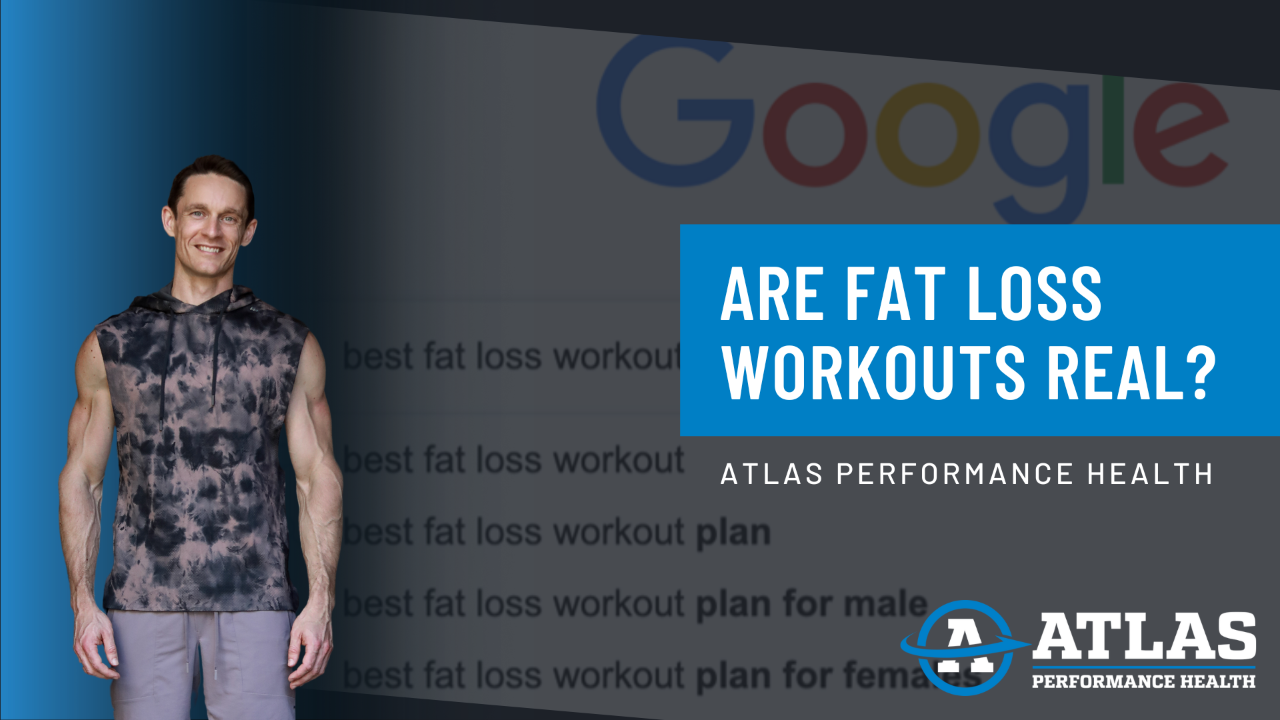
Are Fat Loss Workouts Real?
Jun 02, 2023The internet is amazing as it allows us access to virtually anything we want to know.
Want to find the best fat loss workout? Google it!
Yet, even if your Google search for “best fat loss workout” produces a bunch of viable looking hits, we have a problem.
Despite having pages and pages of search hits, they’re almost all misleading, flawed or just plain wrong! Why?
Because fat loss workouts aren’t real.

Let me now explain why and focus on 2 key reasons. Understanding these reasons will also better help you achieve the physique transformation you desire.
Despite what google may suggest, fat loss is rarely going to be achieved due to a new magical workout you found.
This is because fat loss is a multifaceted process! It’s dictated by many factors and can be achieved numerous different ways.
The one non-negotiable thing you must do is to create a calorie deficit, by altering energy balance. The dilemma is, to achieve sufficient fat loss we must create a sizeable calorie deficit.
Whilst resistance training does indeed burn calories, the reality is that lifting often burns a surprisingly small amount of calories. This is especially the case if you’re weaker, use subpar effort and inferior exercise selection.
Now, consider this scenario. You already lift in the gym 4 x per week doing classic resistance training. However, you now want to lose body fat, so you change up your gym training and start doing “fat loss workouts” instead.
The problem is, if you’re still training 4 x per week, there’ll be little to now impact to your body composition. In fact, there’s a chance you may even make your body composition worse!
Again, this is because exercise activity contributes only a relatively small amount of energy output to your daily expenditure. This is illustrated below, where you can see the 4 key variables that comprise TDEE (total daily energy expenditure).
The largest factor by far is your BMR (basal metabolic rate), yet calorie expenditure via exercise activity or EAT (exercise activity thermogenesis) is drastically less!
Components of Total Daily Energy Expenditure

PMID: 24571926. Components of total daily energy expenditure (TDEE). BMR = basal metabolic rate; NEAT = non-exercise activity thermogenesis; TEF = thermic effect of food; EAT = exercise activity thermogenesis; REE = resting energy expenditure; NREE = non-resting energy expenditure. Adapted from Maclean et al., 2011.
So, if the only change you make to drive fat loss is to switch your training to “fat loss workouts”, minimal to no change will likely occur.
Why? Because there likely wouldn’t be enough extra energy output from the change in training style.
Yet, superior fat loss progress would be seen if you did any of the below:
1/ Reduced your daily calorie intake (nutritional manipulation)
2/ Also increased your energy output other ways
- More incidental activity (steps)
- Higher training frequency (more weekly energy output)
Moving on, there’s another key reason why pursuing fat loss workouts are a bad idea.
Reason #2: Burning More Calories in the Gym Doesn’t = Better Fat Loss
Prioritising burning calories over lifting progression when dieting, may hurt not help your body composition!
This is because a key part of the physique transformation process when dieting is not just fat loss, but also muscle preservation.
The more muscle you preserve, the better your body composition at the end of your diet.
Yet, if your training turns into cardio with dumbbells, you’re unlikely to be continually achieving progressive overload.
Continued progressive overload is likely the number 1 factor which drives muscle gain.
When dieting though, you’ll have insufficient energy to optimally support hypertrophy potential.
Yet, this doesn’t mean progress can’t still occur and that you should drastically change your training style!
Instead, you should still chase progressive overload and muscle gain, it’s just harder to achieve.
Crucially though, if you at worst preserve your strength potential, or ideally you continually get stronger, you’re going to better preserve muscle mass during a fat loss phase!
This is why number 1 priority with resistance training should always be the pursuit of progressive overload.
Doing this aids muscle preservation, strength potential, supports higher training motivation and aids your body composition.
Yet, if you neglect overload for the blind pursuit of more calories burned, you’re heading down the wrong path.

However, this doesn’t mean that you can’t employ some savvy training protocols which are more energy costly. The key is how, when, and why!
So, when it comes to the pursuit of superior fat loss, training shouldn’t be the main driver of the process. Whilst it will support fat loss and add energy output, training should work synergistically with other process to maximise your body composition goals.
This is why nutritional manipulation via a reduction in your calorie intake should be prioritised when dieting.
Especially as a far greater calorie deficit can be created. This not only aids superior fat loss rates but saves you time too!
Because to truly use training to be the sole driver of fat loss, you’re going to need to add a massive amount of it above your norms! Yet, you can still strategically manipulate energy output to support fat loss. You can do this by increasing your daily steps, adding extra cardio, plus slightly modifying how you train, along with how often.
The key though is using the right combination of diet and training protocols to best suit your goal, preferences, and context. If you do this, you’ll achieve superior fat loss and a greater physique transformation.
This is why you should ditch “fat loss workouts”, and instead prioritise training progression coupled with a smarter overall strategy.
Thanks for reading,
Glen Carroll

